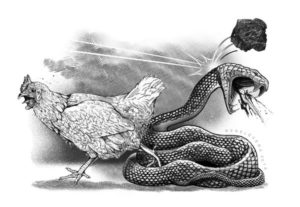When I heard the commotion, I rushed to the small kitchen at the back of the house. The helper was shouting at her husband, our gardener, who held an aluminum ladder in the air and with its leg smashed something on the ground. It was a snake. He had been alerted to its presence by the agitated flapping of the roosters in a nearby pen, and the repeated foot-stamping of two rabbits on their cage floor. Fortunately, he hit the snake’s head with just one stroke.
The man had a similar luck one morning years ago. Our dog was frantically prancing as it barked at something under the car. He checked and, seeing that it was a snake, tossed a stone at the serpent’s head and hit it. He said that he did it with a prayer — a sort of Hail Mary pass.
Idle lots heavily overgrown with weeds and wild flowers surround our lot. Perhaps this explains the prevalence of snakes, which turn up in our yard from time to time. They’re of the color green, not too big, although one or two were the size of a child’s arm.
If it’s any comfort, their number has yet not reached biblical proportions. Scripture tells us that the Lord sent fiery serpents to punish the Israelites who were grumbling about the lack of food and water while they were traveling across the desert. When the serpents bit and killed many of them, the people repented and asked help from Moses, who prayed to the Lord to remove the vipers. Upon the Lord’s instructions, Moses made a bronze serpent and set it on a pole. Those who were bitten and looked at it did not die.
Jesus alluded to this incident when he was talking to Nicodemus. As narrated in the Gospel of John, Jesus told the Pharisee, “And as Moses lifted up the serpent in the wilderness, so must the Son of man be lifted up, that whoever believes in him may have eternal life.”
Clearly, Jesus meant his being crucified and lifted up on a cross — his sacrifice whose significance he summed up in these words, “For God so loved the world that he gave his only Son, that whoever believes in him should not perish but have eternal life.”
While the snakes brought death to the Israelites, a bronze serpent occasioned their healing. Here one may note an ambivalence. I recall a poem by D. H. Lawrence about a snake that emerged from a fissure in an earth wall to drink from a water trough. The sight of the snake filled Lawrence with contradictory feelings — on one hand, of revulsion and fear, which urged him to kill it, and, on the other hand, awe at the serpent’s almost regal manner as it slithered to and from the water. In the end, he decided to throw a piece of log at the snake, but did not hit it, which was now almost inside its hole, into which it completely disappeared. Lawrence regretted his act, finding it petty.
The Israelites feared the serpents, which for them meant death. We know that the best way to handle fear is to confront it, that, for instance, one who experienced a near drowning, should without delay return to the water, the source of one’s trauma. Apparently, as a condition for their healing, the Lord wanted the Israelites to look at a representation of that which plagued them and confront the reason for it — their hard hearts, their speaking out against the Lord, their lack of faith — and so to amend and change their ways.
In a similar way, we gaze at the crucified Jesus elevated on a cross to get to grips with our sinfulness, the cause of his suffering and death, and to turn our back on the old ways and be renewed, and to share in his Resurrection and life.
In his poem, D. H. Lawrence felt sorry for throwing a piece of log at the disappearing snake. “I missed my chance with one of the lords / of life,” he said.
How many of us, by ignoring or defying Christ, or coming to Him too late, miss our chance with the true Lord of life?
Disclaimer: The comments uploaded on this site do not necessarily represent or reflect the views of management and owner of Cebudailynews. We reserve the right to exclude comments that we deem to be inconsistent with our editorial standards.

